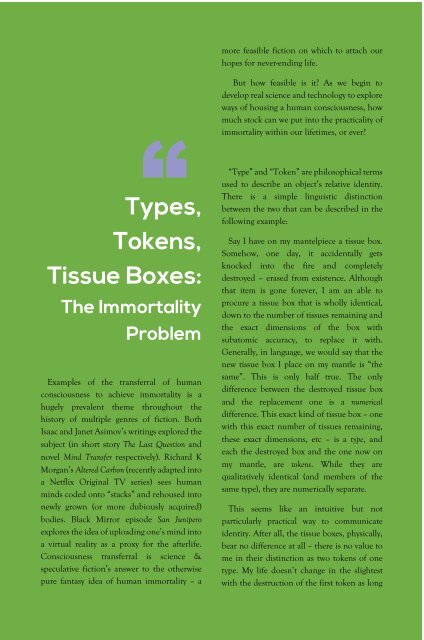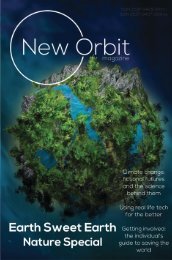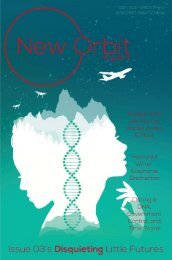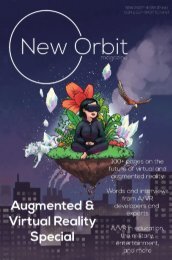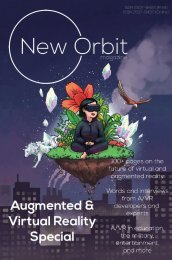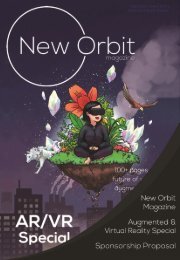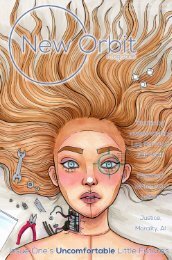New Orbit Magazine: Issue 04, October 2018
Create successful ePaper yourself
Turn your PDF publications into a flip-book with our unique Google optimized e-Paper software.
more feasible fiction on which to attach our<br />
hopes for never-ending life.<br />
But how feasible is it? As we begin to<br />
develop real science and technology to explore<br />
ways of housing a human consciousness, how<br />
much stock can we put into the practicality of<br />
immortality within our lifetimes, or ever?<br />
“Type” and “Token” are philosophical terms<br />
used to describe an object’s relative identity.<br />
There is a simple linguistic distinction<br />
between the two that can be described in the<br />
following example:<br />
Examples of the transferral of human<br />
consciousness to achieve immortality is a<br />
hugely prevalent theme throughout the<br />
history of multiple genres of fiction. Both<br />
Isaac and Janet Asimov’s writings explored the<br />
subject (in short story The Last Question and<br />
novel Mind Transfer respectively). Richard K<br />
Morgan’s Altered Carbon (recently adapted into<br />
a Netflix Original TV series) sees human<br />
minds coded onto “stacks” and rehoused into<br />
newly grown (or more dubiously acquired)<br />
bodies. Black Mirror episode San Junipero<br />
explores the idea of uploading one’s mind into<br />
a virtual reality as a proxy for the afterlife.<br />
Consciousness transferral is science &<br />
speculative fiction’s answer to the otherwise<br />
pure fantasy idea of human immortality – a<br />
Say I have on my mantelpiece a tissue box.<br />
Somehow, one day, it accidentally gets<br />
knocked into the fire and completely<br />
destroyed – erased from existence. Although<br />
that item is gone forever, I am an able to<br />
procure a tissue box that is wholly identical,<br />
down to the number of tissues remaining and<br />
the exact dimensions of the box with<br />
subatomic accuracy, to replace it with.<br />
Generally, in language, we would say that the<br />
new tissue box I place on my mantle is “the<br />
same”. This is only half true. The only<br />
difference between the destroyed tissue box<br />
and the replacement one is a numerical<br />
difference. This exact kind of tissue box – one<br />
with this exact number of tissues remaining,<br />
these exact dimensions, etc – is a type, and<br />
each the destroyed box and the one now on<br />
my mantle, are tokens. While they are<br />
qualitatively identical (and members of the<br />
same type), they are numerically separate.<br />
This seems like an intuitive but not<br />
particularly practical way to communicate<br />
identity. After all, the tissue boxes, physically,<br />
bear no difference at all – there is no value to<br />
me in their distinction as two tokens of one<br />
type. My life doesn’t change in the slightest<br />
with the destruction of the first token as long


